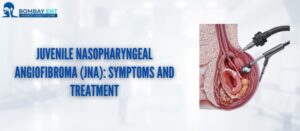
Juvenile Nasopharyngeal Angiofibroma (JNA) is a rare, benign tumor that primarily affects adolescent males. Despite being non-cancerous, JNA can cause significant morbidity due to its aggressive growth and tendency to cause complications such as nasal obstruction, epistaxis (nosebleeds), and cranial base erosion. Understanding the symptoms and treatment options for JNA is crucial for timely diagnosis and effective management, especially for patients and healthcare providers in the field of otolaryngology (ENT).
Understanding Juvenile Nasopharyngeal Angiofibroma (JNA)
What is JNA?
Juvenile Nasopharyngeal Angiofibroma (JNA) is a vascular tumor that originates in the nasopharynx, the area located behind the nose and above the back of the throat. Although it is benign, meaning it does not spread to other parts of the body, JNA can grow locally and invade adjacent structures, including the nasal cavity, sinuses, and even the cranial base. The exact cause of JNA is not well understood, but it is believed to be related to hormonal influences during puberty, as it predominantly affects males between the ages of 10 and 25.
Symptoms of JNA
The symptoms of JNA vary depending on the size and extent of the tumor. Early detection is essential for effective treatment and to prevent complications. Common symptoms include:
1. Nasal Obstruction: One of the earliest and most common symptoms of JNA is nasal obstruction. Patients may experience difficulty breathing through one or both nostrils due to the tumor blocking the nasal passages.
2. Epistaxis (Nosebleeds): Recurrent, profuse nosebleeds are a hallmark symptom of JNA. These nosebleeds can be severe and may require medical intervention to control.
3. Facial Swelling: As the tumor grows, it can cause noticeable swelling in the face, particularly around the nose and cheeks.
4. Hearing Loss: If the tumor extends into the Eustachian tube or middle ear, it can lead to conductive hearing loss.
5. Headaches: Patients with JNA may experience persistent headaches due to the pressure exerted by the tumor on adjacent structures.
6. Nasal Discharge: A constant, often bloody nasal discharge may be present.
7. Proptosis: In advanced cases, the tumor can invade the orbit, causing the eye to protrude (proptosis).
Diagnosis of JNA
Diagnosing JNA involves a combination of clinical evaluation, imaging studies, and sometimes biopsy. ENT specialists play a critical role in the diagnosis and management of JNA ENT. Key diagnostic methods include:
1. Clinical Examination: A thorough examination of the nasal cavity and nasopharynx using an endoscope can reveal the presence of a mass.
2. Imaging Studies: Imaging techniques such as computed tomography (CT) and magnetic resonance imaging (MRI) are essential for determining the size, extent, and exact location of the tumor. These imaging studies help in planning the appropriate treatment strategy.
3. Biopsy: Although JNA is typically diagnosed based on clinical and radiological findings, a biopsy may be performed in uncertain cases to confirm the diagnosis.
Treatment Options for JNA
The treatment of JNA requires a multidisciplinary approach involving ENT specialists, radiologists, and, in some cases, neurosurgeons. The choice of treatment depends on the size, location, and extent of the tumor, as well as the patient’s overall health.
Surgical Treatment
Surgery is the primary treatment for JNA. The goal of surgery is to completely remove the tumor while minimizing complications. Several surgical approaches can be used, including:
1. Endoscopic Surgery: For smaller tumors confined to the nasal cavity and nasopharynx, endoscopic surgery is often preferred. This minimally invasive technique allows for precise removal of the tumor with less morbidity.
2. Open Surgery: In cases where the tumor is large or has invaded critical structures, open surgery may be necessary. Approaches such as lateral rhinotomy, midfacial degloving, or transpalatal approach may be employed depending on the tumor’s extent.
Preoperative Embolization
Preoperative embolization is a procedure used to reduce the blood supply to the tumor, thereby minimizing intraoperative bleeding. During embolization, a catheter is inserted into the blood vessels supplying the tumor, and materials are injected to block these vessels. This technique significantly reduces the risk of excessive bleeding during surgery and improves the safety of tumor removal.
Radiation Therapy
Radiation therapy is typically reserved for recurrent or residual tumors that cannot be completely removed surgically. It can also be considered for patients who are not candidates for surgery due to medical reasons. Advances in radiation therapy techniques, such as intensity-modulated radiation therapy (IMRT), allow for precise targeting of the tumor while sparing surrounding healthy tissue.
Chemotherapy
Chemotherapy is not commonly used as a primary treatment for JNA but may be considered in cases where the tumor is highly aggressive or recurrent. Chemotherapeutic agents can help shrink the tumor and make it more manageable for surgical removal or radiation therapy.
Postoperative Care and Follow-up
Following surgery, patients require careful monitoring and follow-up to detect any signs of recurrence. Regular follow-up visits with an ENT specialist are essential to ensure that the tumor does not regrow and to manage any postoperative complications. Imaging studies may be repeated periodically to assess for recurrence.
Managing Complications
Despite the benign nature of JNA, its treatment can be associated with complications. Some potential complications include:
1. Bleeding: Due to the vascular nature of JNA, bleeding is a common complication during and after surgery. Preoperative embolization can help reduce this risk.
2. Infection: Surgical intervention carries a risk of infection, which can be managed with antibiotics and proper wound care.
3. Recurrence: JNA has a tendency to recur, particularly if the tumor is not completely removed. Regular follow-up and imaging are crucial for early detection of recurrence.
4. Neurological Complications: In cases where the tumor invades the cranial base, neurological complications such as cranial nerve palsies can occur.
Conclusion
Juvenile Nasopharyngeal Angiofibroma (JNA) is a challenging condition that requires a multidisciplinary approach for effective management. Early diagnosis and prompt treatment are essential to prevent complications and improve outcomes. ENT specialists, particularly those with expertise in advanced surgical techniques and endoscopic procedures, play a vital role in the successful treatment of JNA.
At Bombay ENT, we are committed to providing comprehensive care for patients with JNA and other ENT conditions. Our team of experienced ENT specialists in Mumbai, led by Dr Maqsood Ali Khan, is dedicated to delivering the highest standard of care, utilizing the latest advancements in medical technology and surgical techniques.
For patients experiencing symptoms such as nasal obstruction, recurrent nosebleeds, or facial swelling, seeking prompt evaluation and treatment from an ENT specialist is crucial. Early intervention can significantly improve the prognosis and quality of life for individuals affected by Juvenile Nasopharyngeal Angiofibroma.
Whether you are dealing with JNA or any other ENT condition, our team at Bombay ENT is here to provide expert care and support every step of the way. Don’t hesitate to reach out to us for more information or to schedule a consultation with one of our skilled ENT specialists in Mumbai.


